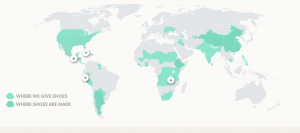
In today’s world, there are many organizations and charities whose main focuses are to help children in developing or third world countries. A notable example is World Vision. As one of the most recognized institutions in Canada, it describes itself as “a non-profit charitable organization dedicated to working with children, families, and communities through child sponsorship”. However, the notion of giving without the expectation of receiving is not a highly favorable concept.

Back in 2006, TOMS Shoes thrived in the fashion industry as a for-profit company. Their “one-for-one” slogan had consumers indulged with the idea of there being a positive impact behind buying a pair of shoes. There was a feeling of satisfaction; knowing what TOMS Shoes stood for, that helped the company flourish. TOMS Shoes “capture[d] the hearts of that young idealistic demographic quite well, satisfying its two greatest cravings simultaneously – one, the desire to [be] part of a change…and two, the desire… to look cool.”
Nonetheless, what is the real impact behind buy-one-give-one? According to Claire Gorden of TIME magazine, TOMS donated 10 million pairs of shoes in the time span of 7 years since their establishment, however, how effective was this really?

There were good intentions behind one-for-one, however, the unfortunate negative outcomes went unseen. The stakeholders in this situation were the shoe businesses of every country TOMS donated to. An alarming study in 2008 discovered “that used clothing donations to Africa were responsible for a 50 percent reduction in employment in [the] sector between 1981 and 2000 on the continent”. Similarly, TOMS put many shoemakers and local businesses out of business, which inevitably took a toll on the economy. I doubt this was intentional, however, I believe consumers should have been educated further than the catchy “one-for-one” slogan, or should stop purchasing TOMS shoes altogether. As Matheson Miller, producer of Poverty Inc. puts it: “poor people aren’t poor because they lack stuff; they’re poor because they lack the infrastructure to create wealth.” Ultimately, there are better solutions to help those in need, without the long term economic repercussions that TOMS inflicted upon third world countries, as the need for mankind to contribute and make a change will always exist.
word count: 356